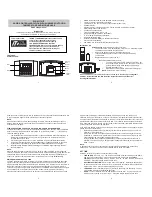
I
f
I
f
r
r
r
I
f
I
the extension is now connected to the com
munications system.
(4) Pick up the extension telephone,
operate the push-to-talk switch when speak
ing, and release it when listening. In other
respects, it is used like an ordinary tele
phone.
(5) At the equipment site the appro
priate REMOTE lamp will light when the
extension telephone is lifted from its cradle
and go out when it is replaced. The system
may be monitored by plugging a headset into
the PHONES jack. This circuit monitors
both transmitted and received signals. The
received signal only may be monitored on the
speaker by turning switch
®
to SPEAKER.
3. S I M P L E
X
N E T W
0
R K
0
P
E R A T I
0
N.
Any number of stations may operate on
one working frequency by sharing time.
Transmitting and receiving are on the same
frequency, the transmitter working only when
the "press-to-talk" button on the handset
is operated. When the button is not pressed,
the receiver is ready to receive any other
station that may want to talk. The four
available frequencies permit any station to be
used on several networks, possibly using
different frequencies for day and night op
eration.
4. T EL E G R A P H A N D T EL E
p
R I N T E R
0
P E R A T I
0
N.
Operation of the SSB-1 for telegraph or
teleprinter use such as shown in figure
12 is as follows:
-
(1) Perform the first 10 steps of para
graph 2a.
(2
)
Turn switch
@
to TELEGRAPH
position.
(3) Plug telegraph key into the KEY
jack and transmit code. While transmitting
adjust the TRANSMITTER GAIN control
@
to obtain intermittent flashing of the PEAK
MODULATION INDICATOR lamp. Break-in
operation is a feature of the SSB-1, i.e.,
pressing the telegraph key automatically
switches the unit from receive to transmit.
A delay circuit holds the unit in the transmit
condition during fast keying. A slight pause
will allow the break-in relay to switch to the
receive condition.
25
SS B-1
TRANSMITTER
RECEIVER
KEY
TRANSMIT
TONE
CONVERTER
TO
POWER
S.OURCE
RECEIVE
HEADPHONES
18382
Figure 12. Telegraph and Teleprinter
Operation
(4) To receive, plug a headset into the
PHONES jack, or if desired, use the speaker
by setting switch
@
to SPEAKER.
(5) To transmit again, just operate the
key.
As illustrated in figure 12, the SSB -1 can
also be used for teleprinting.
The keyed
tone is received by a system with necessary
tone-signal conversion equipment to feed
direct current to the teleprinter. "On-line"
two-way teleprinter operation can be used
through the SSB-1, by simply adding the
necessary teleprinting equipment and ac
cessories. The teleprinter itself does the
switching, from transmit to receive, auto
matically. Teleprinter keying speeds being
in the order of 60 words per minute, the
break-in feature of the SSB-1 cannot be
used. The teleprinter is connected to TB-
104. The keying lead keys only the tone
oscillator, the transmit-receive relay being
operated by an external switch.
5. D U P L E
X
T E L E P H
0
N E
0
P E R A T I
0
N.
Two SSB-1 equipments,
connected as
shown in figure 13, provide a complete
duplex telephone system. Both, connected to
a hybrid transformer, provide full two-fre
quency duplex operation when interconnected
with any wire telephone system. Privacy
equipment may be incorporated as shown in
the figure.
Содержание SSB-1
Страница 1: ...t z LA I E a I I Cl LA I I z z C cc t LA I cc c en U z I LA I 0 IE en CD IE z Cl C U c ...
Страница 4: ... ...
Страница 11: ...T RAN SM I TTER AEO E V Eft E POWER SUPPLY CHASSIS JB 76 Figure 3 Cabinet Top Raised and Chassis Withdrawn 7 ...
Страница 32: ... a c CD c a 00 CD n 0 1 CD 1 CD a ...
Страница 42: ...z 0 1 3 t r l r n ...
Страница 44: ...R i5 Rl23 Cl22 T R114 c Figure 17 Power Supply Bottom View 40 116 rs as6 I J I I I I ...
Страница 45: ... f f c t f c f f f t f f c c c t c f c f f f Figure 18 Speech Clipper Internal View 41 ...
Страница 46: ...5 5 01 FRONT SOTTOM COVER OPEN 18 1 8 Figure 19 Remote Desk Set 42 I I I I I I J ...
Страница 77: ......
Страница 78: ......
Страница 79: ......
















































